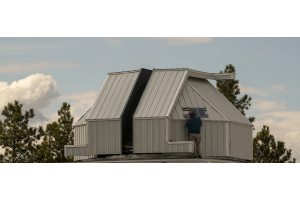comets
Comets have long mystified humans, appearing suddenly like a thief at night and leaving the same. Many comets can be found through a telescope, although some can become bright enough to be seen with the naked eye. It fascinate people because of their composition, origins, and unpredictable nature. For ages, these creatures have fascinated human fantasy and scientific interest. Among all celestial objects, comets capture our imagination thanks to their icy nuclei and glowing tails, which tell us about the solar system's formation conditions and processes.
Most comets steam from the Oort cloud, an area comprising icy objects orbiting far past Pluto. Trillions of comets can be found drifting over the remote regions of the cloud. Sometimes, a star on its erratic path or Jupiter's magnetic field, which is infrequently disturbed, may push a comet toward the inner solar system.
How are Comet tails formed? As the comet approaches the Sun, the solar heat becomes excessive, causing the icy surface to change directly to gas. This process of evaporation forms a radiant coma around the comet's core. The coma and the comet's dust tail are always opposite in motion from the Sun.
We have witnessed the existence of two separate tails in some comets, including Comet Bopp-Hale, a famous comet with a tail consisting of ions blown away by the solar wind. The next one is the solar wind tail, which is the sign of the Sun's magnetic field and is directed away from the sun.
What are Famous Comets?
Among the most renowned comets is Halley's Comet, known to make a 76-year orbit around the Sun. It was last visible in 1986, and in 2061, it will return, which will be its following approach. 1997 belonged to Comet Hale-Bopp, which streaked through the night sky for 18 months and remained bright.
Comet ISON is the latest example of this phenomenon. In late 2013, it failed to survive when it approached the sun, although it was expected to return with a tremendous light show.
Viewing a comet is not that easy. Here are some tips when hunting for a bright comet and observing its tail:
- Use a pair of binoculars or a first-focal-length telescope
- Find a location with minimal artificial light
- Looking for a clear, open sky, preferably in a country area at night with no interference from artificial light sources
Comets are faint, subtle objects that provide firsthand insights into our solar system's formation. They impact the sun, forming precursors for life's like water and amino acids on planets. Despite their faint presence, comets appear bright and wondrous when they approach the sun. Astronomical levels study comets to understand the genesis of our solar system. Comets' composition and activity can be inferred through telescope observations, and as technologies advance, human understanding can reach the principles beneath the fossil remnants of planet formation. Comets are leftover debris from the starting material that formed planets, and through comet research, we uncover new information about our solar system's origins.

Throughout human history, comets in different civilizations have considered them the premonition of misfortune and objects of desire. Stellar masers are another form of masers associated with stars. With glowing comas and tails of millions of kilometers in length, they offer spectacular night views.
Accurate amateur comet observation is crucial for understanding the early solar system and identifying extraterrestrial life. Avoiding direct eye damage, using the right filters, and consulting astronomical experts for recommendations are essential. Researchers should elevate equipment to ensure accurate observations. Accuracy is vital for studying comets, and even without collecting scientific data, it can help maintain the prominence of comets among professional and hobbyist observers.

Fall and winter comets bring more than cozy sweaters and snowflakes; they usher in a celestial treat – fall and winter comets gracing the night sky. During these chilly seasons, stargazers can anticipate the appearance of these cosmic wanderers, adding a dash of celestial magic to the crisp evenings. Fall comets, often characterized by their glowing comas and distinctive tails, capture the imagination as they travel through the vast cosmic expanse.
The Beauty of Autumn and Winter Comets
Fall and winter comets leave stargazing enthusiasts in suspense, as unstable as comic pranksters, twinkling with their unpredictable brilliance. Their awe-inspiring brightness negates the assumptions, turning night stargazing into a thrilling experience.
Optimal Viewing Angles
The longer nights of winter offer a fantastic opportunity to observe fall and winter comets, making them even more visible against a starry sky backdrop in a chilly night. The dazzling of these comets is not only owing to their brilliance but also unpredictability, leaving a celestial ink on the canvas of the cold night.
A Grande Pursuit
Chasing fall and winter comets is like playing a cosmic treasure hunt in the starry sky. Anyone who is a stargazer will be mesmerized by their celestial beauty. As telescope adventurers brave the frigid temperatures, they can watch these splendid revelers dance in the sky, transforming the nighttime into a cosmic festival.
Unique Experiences and Fun Activities.
The fall and winter comets are unlike others because of their unpredictability; each time they appear, the experience is amazing. The changing luminosity of these bodies surprises visitors when they look at them with a telescope and are dressed in cold-weather clothing. This is a rewarding activity, especially for sky enthusiasts at night.

Binoculars or telescopes are both excellent choices. Even modest magnification, like with binoculars, lets you see comets and their tails. Even small telescopes reveal more details in celestial bodies, capturing more light and offering deeper views.
Preparation and Location
To begin your comet excursion, venture out of the city to find a considerable space with a broad skyline uncrowded with city lights. With the clock hitting just the high time, comets know how to flaunt the celestial bling during the gloomy hours of pre-morning or after the sun goes down. If astronomy apps and websites are your things, take advantage of the latest astronomy news about new comets that boast as the cutting-edge celestial a must.
Observation and Engagement
This observatory party requires meteorological conditions and an unobstructed view to capture comets in their glory. Camera lovers should switch to manual mode and use a tripod to capture these celestial dance moves. Being dedicated space explorers, generous with time, and equipped with the right gadgets is essential for immortalizing these moments in the sky. Be generous with your time and be prepared to witness comets exhibiting their celestial dance moves before the show ends.






